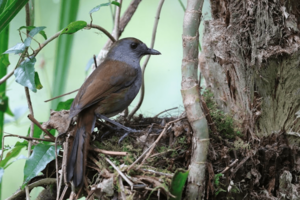Bagobo babbler facts for kids
Quick facts for kids Bagobo babbler |
|
|---|---|
 |
|
| Conservation status | |
| Scientific classification | |
| Genus: |
Leonardina
|
| Species: |
woodi
|
| Synonyms | |
|
Trichastoma woodi (Mearns, 1905) |
|
The Bagobo babbler or Bagobo robin (Leonardina woodi) is a unique bird found only in the Philippines. Specifically, it lives on the island of Mindanao. This bird is the only species in its group, which scientists call "monotypic." Its scientific classification has changed many times. Currently, it is thought to belong to the Muscicapidae family, also known as the Old World flycatchers.
This bird lives in damp mountain forests up to 2,030 meters (about 6,660 feet) above sea level. It gets its name from the Bagobo tribe, who live in the same area.
What the Bagobo Babbler Looks Like
The Bagobo babbler is a medium-sized bird that spends most of its time on the ground. It's not seen very often because it's quite shy!
- Its upper body, from its head to its tail, is a reddish-brown color.
- Its underside is gray, but its throat is white.
- The area from its lower belly to the base of its tail is also reddish-brown.
- It has a strong black beak, long legs, and large feet.
The Bagobo babbler looks a bit like the long-tailed bush warbler. However, the babbler does not have a pale stripe above its eye. It also does not hold its tail pointing upwards. Its call is a very high-pitched whistle, sometimes mixed with harsh, scratchy sounds.
Scientists don't know a lot about this bird because it is so secretive. Even its scientific family (its "taxonomy") is still being studied. It was once placed in the Old World babbler family, then another family called Pellorneidae. Now, studies suggest it belongs to the Muscicapidae family. Some scientists even think it might belong to a completely new bird family!
Where It Lives and Its Status
The Bagobo babbler mainly lives in moist forests on mountainsides. You can find it at elevations from 500 to 2,000 meters (about 1,640 to 6,560 feet). This bird stays close to the ground. It is rarely seen more than 5 meters (about 16 feet) above the forest floor.
The International Union for Conservation of Nature (IUCN) has listed this bird as a Least-concern species. This means it is not currently in danger of extinction. However, scientists still don't have much information about how many Bagobo babblers there are.
Before 1996, people thought this bird was in trouble. It was even listed as a Vulnerable species. But recent research by BirdLife International has shown that there are more of these birds than previously thought. While the Bagobo babbler lives in a small area, it is quite common in its habitat.
Its mountain home is safer from deforestation (when forests are cut down) compared to forests in lower areas. Even so, some deforestation still happens in these mountain regions, just not as much as in the lowlands.


